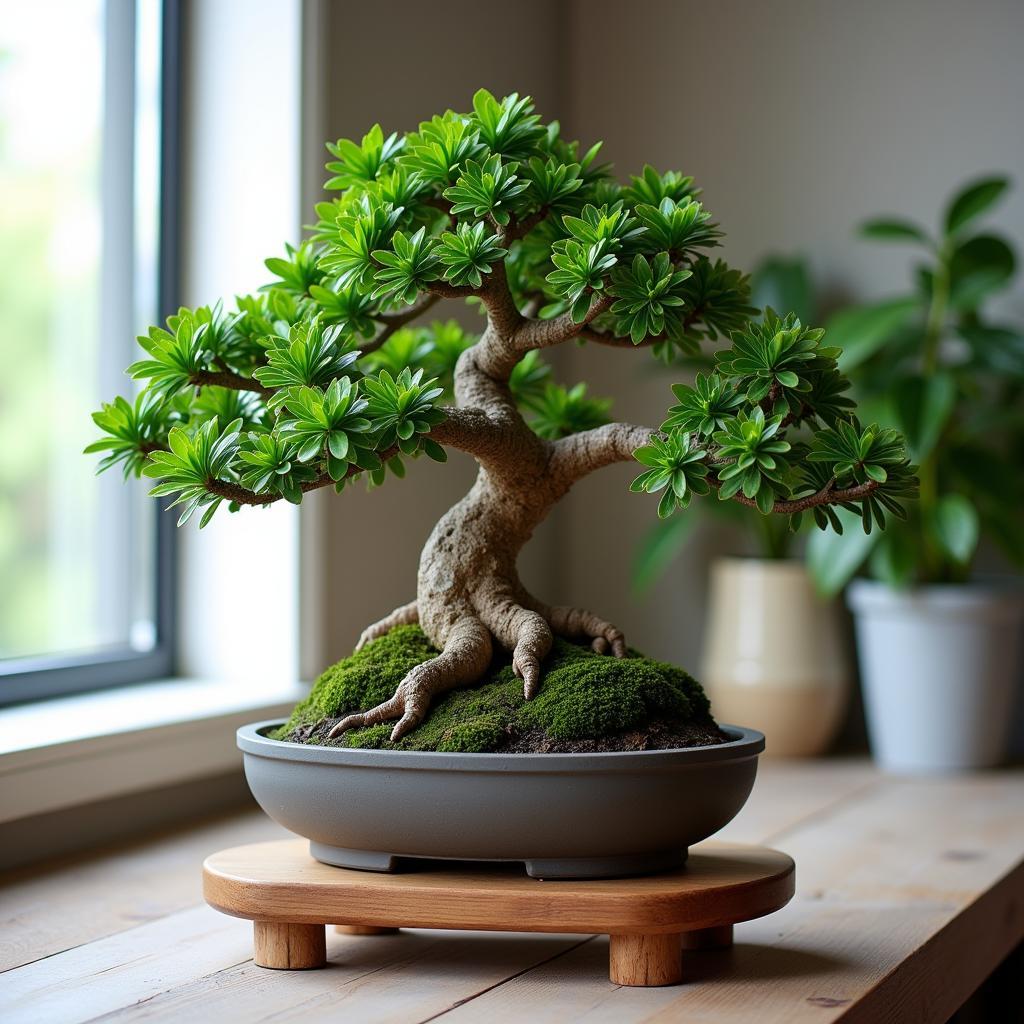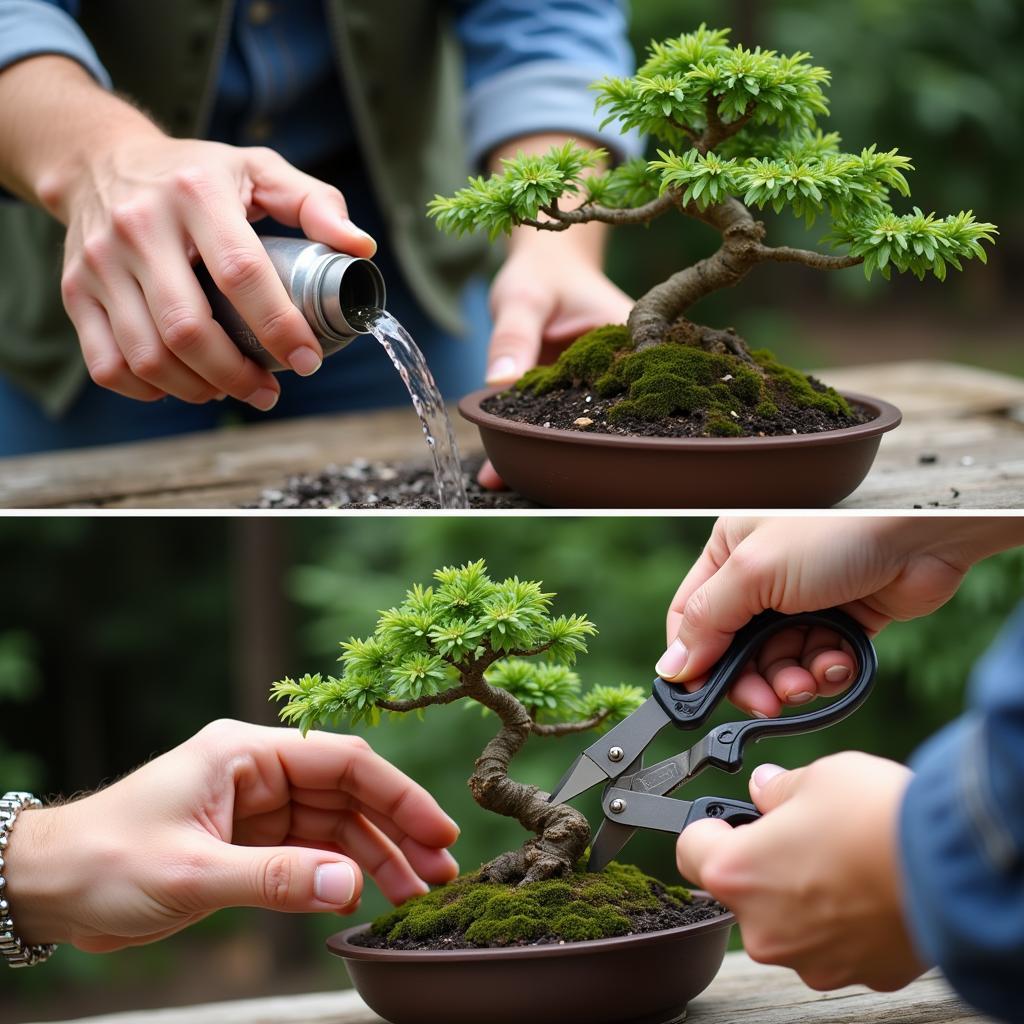Decorative Bonsai: The Art of Miniature Trees
December 30, 2024Decorative Bonsai trees have captivated enthusiasts for centuries with their unique blend of artistry and horticulture. These miniature trees, meticulously shaped and pruned, represent a living art form that brings a touch of nature and tranquility to any space.  Decorative bonsai tree displayed on a wooden stand in a brightly lit indoor setting.
Decorative bonsai tree displayed on a wooden stand in a brightly lit indoor setting.
Understanding the Allure of Decorative Bonsai
Bonsai is more than just a plant; it’s a symbol of patience, balance, and harmony. The practice originated in China over a thousand years ago and later evolved into a refined art form in Japan. Creating and caring for a decorative bonsai requires dedication and an understanding of the tree’s specific needs. Choosing the right bonsai for your space and lifestyle is an important first step.
Choosing the Right Decorative Bonsai for You
From the cascading elegance of a weeping willow to the sturdy strength of a blackberry bonsai tree, there’s a bonsai variety to suit every aesthetic. Consider factors such as size, style, and maintenance requirements when making your selection. Some popular choices include ficus, juniper, and maple bonsai trees. Each species offers its unique challenges and rewards, making the journey of bonsai cultivation all the more rewarding.
Essential Care Tips for Decorative Bonsai
Maintaining a thriving decorative bonsai requires attention to detail and a commitment to regular care. Proper watering, pruning, and repotting are essential for the tree’s health and longevity.  Close-up of hands performing watering and pruning techniques on a decorative bonsai tree.
Close-up of hands performing watering and pruning techniques on a decorative bonsai tree.
Watering Your Bonsai: Finding the Right Balance
Overwatering is a common mistake that can lead to root rot and other problems. The frequency of watering depends on several factors, including the type of tree, the size of the pot, and the climate. It’s important to allow the soil to dry slightly between waterings.
Pruning Techniques for a Stunning Decorative Bonsai
Pruning is essential for shaping the bonsai and promoting healthy growth. Different techniques are used to achieve various styles, from the classic upright form to the more dramatic cascading styles. Regular trimming helps maintain the miniature size and enhances the aesthetic appeal of the bonsai.
Repotting: Giving Your Bonsai Room to Grow
Repotting is necessary to replenish the soil and provide the roots with adequate space. This is typically done every two to three years, depending on the species and the growth rate of the tree. Choosing the right soil mix and pot size is crucial for the bonsai’s continued health.
Creating a Bonsai Display: Enhancing Your Space
Decorative bonsai can be displayed in various ways to create a focal point in your home or office. Consider using a rustic screen door as a backdrop to showcase your bonsai collection. Adding elements like rocks, moss, and small figurines can further enhance the aesthetic appeal.
Imagine a serene corner bathed in the gentle glow of a light up canopy with your bonsai as the centerpiece. This creates a peaceful and inviting atmosphere, allowing you to appreciate the beauty of your miniature tree.
Conclusion: Embracing the Art of Decorative Bonsai
Decorative bonsai offers a unique opportunity to connect with nature and express your creativity. From selecting the perfect tree to mastering the art of pruning and shaping, the journey of bonsai cultivation is a rewarding experience. By following these essential care tips, you can ensure that your decorative bonsai thrives and brings beauty to your space for years to come.
FAQ
- How often should I water my bonsai?
- What type of soil is best for bonsai?
- When should I repot my bonsai?
- What are the common bonsai styles?
- How can I protect my bonsai from pests and diseases?
- What tools do I need for bonsai care?
- Where can I find more information about bonsai care?
Common Bonsai Scenarios and Questions
Scenario 1: Yellowing leaves – This could indicate overwatering, underwatering, or nutrient deficiency.
Scenario 2: Dropping leaves – This could be due to temperature fluctuations, insufficient light, or pests.
Scenario 3: No new growth – Check for rootbound conditions or inadequate fertilization.
Further Exploration:
Explore our other articles on specific bonsai species and advanced care techniques. Learn more about creating intricate bonsai displays and the history of this ancient art form.
Need Help with Your Decorative Bonsai?
For any questions or assistance, please contact us: Phone: 0915117113, Email: [email protected]. You can also visit us at: Hamlet 3, Binh An Hamlet, Phu Thuong Commune, Vietnam, Binh Phuoc 830000, Vietnam. Our customer service team is available 24/7.